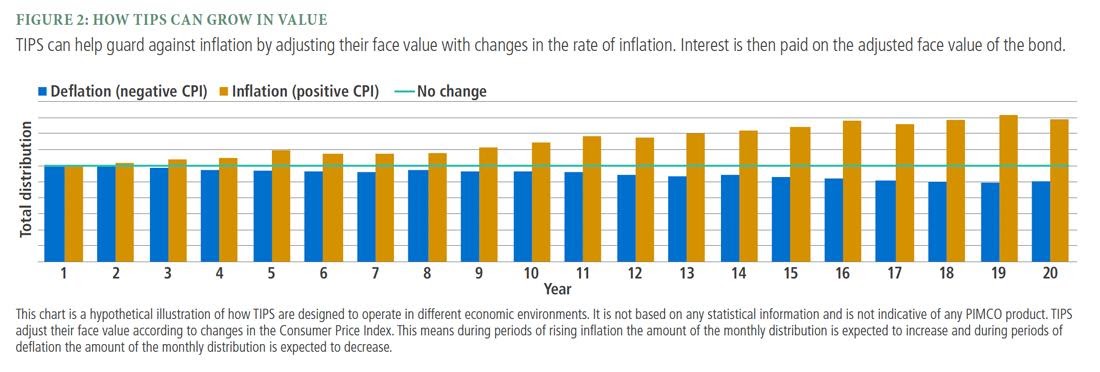And while the U.S. is nowhere near reaching Zimbabwe-style hyper-inflation rates just yet, the potential for higher prices and a return to normal with regards to inflation is considered market-wise a certainty. The time to prepare is now.
That’s why investors should take a tip with regards to, well,TIPs.
Long ignored in our recent low-inflation world, Treasury Inflation-Protected Securities (TIPS) are still one of the best instruments for fighting rising prices. The bonds can be complex to understand, but they can also be used to form a base of inflation-fighting cash. Given the recent return of inflation, now could be the best time to consider adding TIPs to your fixed-income portfolio.
To learn more about different ways to generate income, visit our Fixed Income Channel.
Rising Inflation
Consumer prices have surged. According to the Bureau of Labor Statistics, the latest Consumer Price Index for All Urban Consumers (CPI-U) figures for April showed a whopping 4.2% year-over-year increase. This follows March’s 2.6% jump to consumer prices. Producers’ prices have also seen a similar surge higher.
Perhaps worse is that the jump in inflation could be a return to normal. The Fed continues to support a policy of inflation-targeting, which lets the central bank run above its 2% target, in order to fight high unemployment. Meanwhile, supply constraints and shortages due to the pandemic have continued to boost prices. And, finally, the opening of the world’s economy has continued to support growth with stimulus measures adding an extra oomph.
With all of this, we could be back to a normalized 2 to 3% inflation rate per year.
TIPS to the Rescue
The bonds are a sort of weird animal in the fixed-income world. The easy way to think about TIPS is a bond that provides investors a fixed yield plus an extra boost of continually ongoing adjustments designed to offset inflation. However, they are a bit more complex than just that.
For starters, TIPS function like traditional savings bonds or zero-coupon bonds. What that means is that investors don’t actually receive interest payments each year. When you buy a regular Treasury bond, like the benchmark 10-year, twice a year, Uncle Sam will send you a check for the interest. Most corporate bonds function in the same way. Whereas, this isn’t the case for TIPS.
For TIPS, their face value is tied to the CPI and adjustments are based on rates of inflation. The Treasury pays the set coupon interest on the adjusted face value of the bond, so investors get this inflation adjustment stream of income. When the bond matures, investors will receive the original value plus all of the inflation kickers that were added to the bond.
In practice, it looks like this: An investor buys $1,000 worth of a 10-year TIPS with a 2% coupon rate. In the first year, inflation spikes to 3%, and then the face value of the bond rises by that amount to $1,030. The investor now receives their coupon payment of 2%. Since the face of the bond has risen, they’ll get $20.60 this year.
You can see by this chart from PIMCO how TIPS basically function with regards to inflation fighting.

Source: PIMCO
A Few Caveats to Look out For
Secondly, despite not paying out their interest, you’ll pay taxes on those coupon payments each year as you receive them. Dubbed “phantom income,” this tax can be avoided by holding TIPS in tax-deferred or tax-free accounts.
Finally, TIPS are subjected to the same rules as regular bonds when it comes to interest rates. When the Fed raises rates, newly issued bonds will carry a higher coupon. This tends to send the price of already issued bonds lower in order to match the new higher coupon rate. If you’re planning on holding a TIPs to maturity, this isn’t an issue. But if you need to sell, you could experience losses. This plays into the idea of break-even rates versus regular bonds. TIPS often trade on the secondary market at discounts or premiums based on expectations for future inflation.
How to Use TIPS
You can buy them directly from the Treasury via their Treasury Direct website for a minimum of $100. You can have the Treasury withhold phantom income taxes as well. Buying TIPS directly is great if you can hold them until maturity.
However, there are countless mutual funds and ETFs that hold TIPS as their assets. The iShares TIPS Bond ETF (TIP) is the largest ETF in the sector, while the Vanguard Inflation-Protected Bond (VIPSX ) is a top-rated mutual fund. Both offer broad exposure to TIPS and can be used to quickly gain exposure. Better still, they can be placed inside tax-deferred accounts like IRAs to avoid phantom taxes. Investors can also find ETFs and mutual funds that focus on the smaller end of the maturity scale to help protect against rising interest rates.
The Bottom Line
Use the Mutual Funds Screener to find the security that meet your investment criteria.

